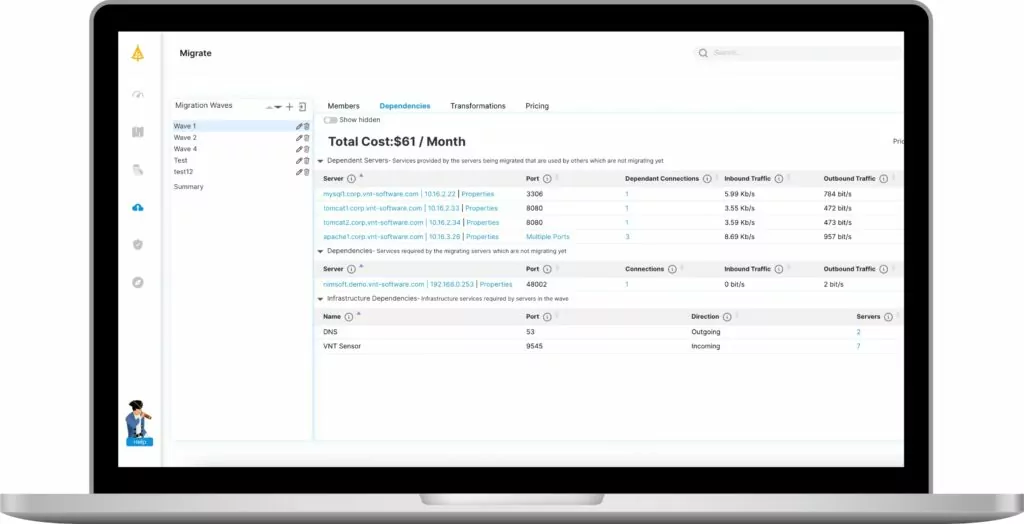Whispers about cloud repatriation began a few years ago. Initially, no one gave it much thought. But gradually, those whispers have grown louder, and the phrase “cloud repatriation” has become mainstream. There are many reasons why it’s becoming a hot topic and gaining traction with every passing year.
Cloud repatriation is the process of companies migrating their data, applications, and workloads from cloud-based infrastructure to on-premises infrastructure. The file-hosting service company Dropbox was the first significant name to leave the cloud in 2015. Since then, numerous other companies, of various sizes and from diverse industries, have followed suit.
Table of Contents
ToggleIn 2021, 451 Research conducted a study that revealed that only 52% of the 600 surveyed companies who moved to the cloud chose to remain there. The other 48%, to some degree or another, moved back to physical, and typically more private, infrastructure.
This phenomenon has rightly puzzled many, especially considering how revolutionary it seemed when thousands of companies around the world left their data centers and moved to public clouds. If the cloud was poised as the infrastructure solution of the future, then why are so many companies leaving, and at an accelerating pace?
What is Cloud Repatriation?
Cloud repatriation is when companies undergo an infrastructure migration that involves leaving the cloud and moving to on-premises. Cloud repatriation doesn’t always mean complete migration; it can result in hybrid models where both cloud and on-premises infrastructure are utilized for different purposes.
The reason why so many companies are, at the very least, curious about cloud repatriation is that they have realized first-hand that the cloud isn’t the utopian solution that it was marketed to be. While the cloud offers benefits, there are many companies whose circumstances, objectives, and workloads just don’t align with what the cloud offers.
The stories of the companies who benefited from the cloud have, until now, been the dominant narrative. Today, many companies have moved back to on-premises because of costs, vendor lock-in, compliance, and security. Others are leveraging cloud repatriation to optimize their operations. None of those companies would have known that on-premises infrastructure is the best option for them without having tried the alternative—the cloud—first.
It’s vital for any organization that’s looking into cloud repatriation to understand the advantages, influencing factors, challenges, and potential roadmaps before making a decision. If conducted with thought, care, and precision, cloud repatriation can prove profoundly transformative for many businesses.
The Advantages of Cloud Repatriation
Despite the continuous trend of cloud adoption, organizations must consider several advantages to cloud repatriation when evaluating their cloud strategy.
Cost Savings
The cloud was supposed to be a cost-saving option for companies. But things didn’t universally pan out that way. Numerous companies that started leaking money while using an exclusively cloud-based infrastructure. For these organizations, the first and primary advantage of cloud repatriation is cost savings.
The cloud was a cheaper option for some initially, because it’s an optimal solution for irregular and highly fluctuating workloads. Businesses with predictable and steady workloads, though, found the cloud to be detrimental to their operations and ended up spending more than planned.
By letting go of cloud services, associated vendor lock-ins, and other third-party add-ons, businesses free themselves up financially. This helps them to increase profit margins and put their infrastructure budgets to better use.
Improved Data Privacy and Security
A company’s data is its most valuable asset. The quantity and quality of data that a business possesses can provide a significant competitive advantage in today’s crowded and saturated markets. Therefore, the fact that 45% of data breaches in 2022 were cloud-based is a concern for most companies.
Cloud misconfiguration was a major cause of the data breaches last year. There are robust cybersecurity options available for companies to protect their cloud infrastructures. However, these fortifications are expensive, exceeding the security budgets of most companies. The private and protected nature of on-premises data centers offers organizations improved data privacy and security.
Better Regulatory Compliance
The cloud is governed by various regulations such as NIST (National Institute of Standards and Technology,) PIPEDA (Personal Information Protection and Electronic Documents Act,) and PCI DSS (Payment Card Industry Data Security Standard.) Staying compliant with these various regulations is the responsibility of every company. But managing complex regulatory frameworks in the cloud is more challenging as organizations don’t have complete control over cloud infrastructure.
Increased Control of IT Infrastructure
One of the biggest advantages of cloud repatriation is increased control over IT infrastructure. In cloud environments, companies often have to work within the framework and toolkits of their providers. This means that various limitations exist, and companies have to dance to the tune of their infrastructure rather than vice versa.
Cloud repatriation allows organizations to innovate with a blank slate, free from the operational roadblocks and bottlenecks of the past. It also lets them bring in any hardware or software that they view as being most suitable for meeting their objectives.
In-house IT teams can design, configure, and utilize on-premises infrastructure with superior control than the cloud offers. This control can be a significant differentiator between a company and its cloud-based competitors.
What Are the Factors Driving Cloud Repatriation?
There are many factors influencing the departure from the cloud and the exploration of on-premises infrastructure. One reason is maturing cloud technologies, which bring with them a series of inconveniences and complexities—like service outages and downtime. Another major pitfall of cloud infrastructure is a lack of flexibility and customization.
In surveys conducted by 415 Research in 2022, 36.2% of respondents cited information security concerns as their primary reason for leaving public clouds. This marked increase in awareness of the risks associated with public clouds is a major motivation for cloud repatriation. Businesses simply can’t afford to take risks involving their high-value assets.
Twenty-two percent of 415 Research’s respondents claimed that data sovereignty issues were the main reason for leaving the cloud, while 18.1% cited regulatory and governance requirements. The emergence of new regulations and associated stress of staying compliant is another leading cause of repatriation.
Lastly, growth in edge computing is proving to be a significant reason why organizations are leaving the cloud. Edge computing, in simple terms, is when data processing happens in close proximity to data generation. This means that data doesn’t have to be sent to external networks to be processed—it can be done on-premises. The benefits of edge computing (including enhanced operational efficiency, cost optimization, scalability, and robust security) are alluring to many organizations that are currently cloud-based. It’s no surprise that edge computing is driving cloud repatriation.
The Challenges of Cloud Repatriation
Although cloud repatriation certainly comes with many advantages, the process can be challenging. Companies must carefully evaluate the risks and complexities involved in moving away from the cloud.
Complex Migration Process
Cloud repatriation is a complex process that must be handled responsibly. The process is especially difficult for those who are well-settled in a cloud environment. Only a slow and steady method will yield positive results.
Businesses should ensure that their on-premises infrastructure is secure and safe for workloads before meticulously migrating their cloud data and applications in phases. Cloud service providers are also unlikely to help with their exit; employing infrastructure migration experts to help with repatriation is vital.
High Investments in Infrastructure and Expertise
Setting up robust on-premises infrastructure can be frighteningly expensive. Companies that want to leave the cloud are likely focused on long-term gains, because the initial investments required to establish on-premises infrastructure can be immense. In addition to building the infrastructure, they also need to staff it with top IT specialists who don’t come cheap.
A typical in-house data center costs around $1000 per square foot. An alternate metric shows a figure of between $7 and $12 million per megawatt of IT workload. Building on-premises infrastructure is an expensive proposition, so companies must keep in mind its long-term advantages.
Context is paramount when looking at hardware expenses for on-premises infrastructure. The American software company Basecamp is about to spend $840,000 per year for all of its on-premises operations. Basecamp made a commitment to leave the cloud in 2022 and has been on a repatriation journey since then.
While $840,000 sounds like a lot of money for an SME like Basecamp, it’s significantly less than the $2.3 million they were previously spending on cloud use for a year. Over a five-year period, cloud repatriation is about to save Basecamp a staggering $7 million. Therefore, while high figures can intimidate companies, the potential cost savings deserves an in-depth study.
Challenges with Data Management
We established earlier that data is a company’s most valuable asset. That’s why one of the biggest cloud repatriation challenges is data management, a gargantuan task even without the complexities of needing to withstand an infrastructure migration.
Data is rarely migrated in one swift go. Therefore, it’s important that data is identified and categorized based on location and format, and migrated with a carefully designed strategy using best practices and tools. Companies need to remember that the challenges of cloud repatriation, like data management, are hurdles and not roadblocks.
Potential Impact on Performance and Availability
The key to successful cloud repatriation is ensuring that transitions are as seamless as possible. When workloads are disengaged from the cloud and dispatched to their new on-premises environments, a method and sequence should be used that minimize downtime or noticeable disruption.
If cloud repatriation is conducted poorly, companies will likely experience downtime, resulting in service disruptions that will negatively impact their clients. Companies never want to be in a position where their key product or service is required but unavailable. Such situations in today’s world could result in irrecoverable damage.
How to Plan and Execute a Successful Cloud Repatriation Program
A well-planned and executed repatriation program can help enterprises improve security, increase flexibility, and reduce costs, while minimizing potential challenges.
Assessment of Current IT Infrastructure
Cloud repatriation begins with what currently exists. The raw material for successful cloud repatriation is the existing cloud-based data, applications, and workloads. Companies must thoroughly assess their current cloud topography, identify key assets, map dependencies, and meticulously document their findings.
Cost vs. Benefit Evaluation
Leaving the cloud isn’t a cheap or easy move. It’s important to evaluate the costs versus the benefits. If the long-term advantages outweigh a few hurdles that cloud repatriation might throw at companies, then it’s worth committing to the process and making the necessary investments in the company’s future.
Migration Planning
It all begins with a strategy. Organizations cannot leave the cloud without a detailed plan designed with the best interests of all stakeholders in mind, a long-term vision with thorough business logic, and financial pragmatism. A robust migration strategy is non-negotiable for a successful migration.
Build a Team of Experts
Basic IT skills aren’t going to be sufficient to pivot from the cloud to on-premises infrastructure. Cloud repatriation requires a team of experts who will lead the project every step of the way, innovate to tackle inevitable challenges, and see it through to completion.
In Conclusion

Cloud repatriation is becoming more popular. The adoption of on-premises infrastructure is witnessing a resurgence because companies are trying to save money, better secure their data, ensure compliance with various regulations, and increase control over their own IT infrastructure. Beyond individual reasons why companies want to leave the cloud, general drawbacks include maturing cloud technologies, more awareness of cloud-based data breaches, constantly changing regulations, and the rising trend of edge computing all push companies toward cloud repatriation.
Cloud repatriation is complex, expensive, and can potentially harm data protection and operational performance. However, with a robust IT team, an honest assessment of existing cloud infrastructure, a cost vs. benefit analysis, and a world-class migration strategy, there’s no reason why cloud repatriation can’t be successful.
In the future, we predict that many organizations, to varying degrees, will use a hybrid infrastructure. Companies who want to leave the cloud can use IT infrastructure migration experts such as Faddom. Whether you want to migrate or repatriate, our software maps your entire hybrid IT infrastructure and business-critical applications both on premises and in the cloud in as little as 60 minutes so you can get an accurate assessment and do it quickly, safely, and cost-effectively.
Just start a free trial today!









